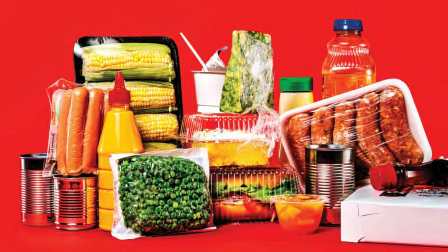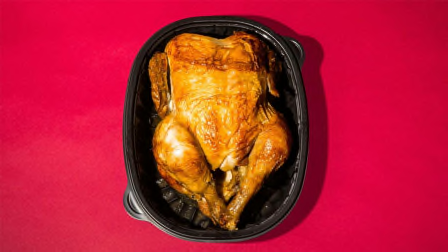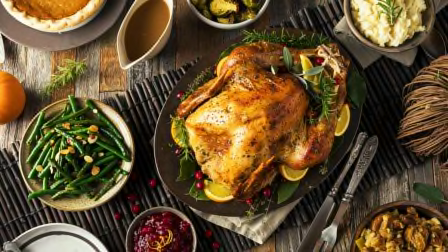15 Ways to Save on Thanksgiving Food Shopping
Even now, you can find savings on holiday groceries if you know where to look

Americans have another reason to give thanks this year: Food prices for a traditional Thanksgiving dinner have come down for the third year in a row, according to the American Farm Bureau Federation’s annual market basket survey.
A classic holiday meal for 10, including turkey and all the trimmings, will cost $55.18 on average, or approximately $5.52 per person, according to the AFBF’s estimate. That represents a 5 percent decrease from 2024.
Although that’s good news, three years of declining costs haven’t completely offset the increases that led to the record high of $64.05 in 2022. So for many families, including an increasing number facing food insecurity, it’s still important to save where they can.
A 16 percent decrease in the retail price of the bird, the meal’s centerpiece for many families, helped lower the cost of the meal this year. A 16-pound frozen turkey is $21.50, on average, according to the AFBF. Bird flu and other challenges actually increased the wholesale price of fresh turkey from 2024, but grocers’ Thanksgiving deals have been bringing retail prices down.
Other typical parts of the meal also cost less. Dinner rolls ($3.56 for 12) and cubed stuffing mix ($3.71 for 14 ounces) are down 15 and 9 percent, respectively. But your veggie sides may cost more to put on the table. Sweet potatoes ($4 for 3 pounds) are up 37 percent this year, according to the AFBF survey, and a 1-pound veggie tray ($1.36) is up 61 percent.
As Thanksgiving approaches, turkey prices are continuing to slide. The Department of Agriculture’s Agricultural Marketing Service data show that the average price per pound for a frozen turkey has dropped to 97 cents since the Farm Bureau’s “volunteer shoppers” reported $1.34 per-pound prices during the first week of November.
“It’s encouraging to see some relief in the price of turkeys, as it is typically the most expensive part of the meal,” AFBF economist Faith Parum said in a press release. “Farmers are still working to rebuild turkey flocks that were devastated by avian influenza, but overall demand has also fallen. The combination will help ensure turkey will remain an affordable option for families celebrating Thanksgiving.”
Bargains Are Still Out There
All of this is to say that grabbing a good—or free—deal on a gobbler is still within reach. As for other Thanksgiving foods, you can use various tactics to find the best prices.
“Thanksgiving is actually one of the most economical meals you can host,” says Annette Economides of Scottsdale, Ariz., who, with her husband Steve, runs the website MoneySmartFamily. The key to saving, she says, is to plan ahead, look for sales, be willing to shop at more than one store, and follow common money-saving tips, such as the ones below.
Pre-Thanksgiving Tips
1. Check out the turkey promotions. Scan grocers’ circulars and ads for bargains, including free-turkey promotions. Most require you to spend before you can nab the bird.
Go to Consumer Reports’ deals page for updates on holiday sales, expert product reviews, insider tips on shopping, and much more.
Year-Round Tactics
7. Check the circulars. Planning well to minimize your trips to the store can save you time and reduce your impulse purchases. “If you can save $30 by spending 15 minutes looking at grocery ads, is it worth it?” Economides asks. “I certainly think it is.”
8. Get a store loyalty card. Most grocery chains’ loyalty programs offer special member deals. Some, including those of Kroger, Hy-Vee, and Stop & Shop, among others, also let you build rewards toward gas purchases at affiliated gas stations. Downloading the store program’s app will keep you in the know about deals, and some allow you to track and organize store coupons. Remember, though, that in return for these perks, you are sharing information about your shopping habits.
9. Use shopping apps. A couple we like are Ibotta and Flipp. They both identify manufacturer promotions and coupons, and offer direct rebates after you buy from a participating retailer. Again, keep in mind that you are sharing information about your shopping habits through these apps.
10. Compare unit prices. Unit price shelf stickers under each product can help you better compare prices of like items. If a store doesn’t have the stickers, download a unit price calculator on your smartphone to do the work for you. We found free ones for both iOS and Android phones.
11. Select store brands. Supermarkets have been upgrading the quality of store-brand foods and beverages, and their cost is at least 15 to 25 percent less than that of name-brand products of the same type, says Burt Flickinger III, managing director at Strategic Resource Group, a retail consulting company based in New York. You can often find store brands alongside comparable name-brand items.
12. Use a cash-back credit card. Some offer rewards for grocery purchases. If you’re looking for a new card, consider the American Express Blue Cash Preferred card, which returns 6 percent on the first $6,000 in groceries purchased at U.S. supermarkets each year, among other benefits. The card currently offers a $250 rebate for spending $3,000 within the first six months, and the $95 annual fee is waived for the first year. Keep in mind that you may need a credit score of 700 or higher to qualify. After a 0 percent introductory annual percentage rate on the card for the first 12 months, the APR ranges from 19.74 percent to 28.74 percent, so it’s best to use it only if you pay off your balance each month.
13. Embrace coupons. Most grocers will accept manufacturers’ paper coupons, and may even double or triple their value at checkout. Some retailers do it daily or weekly, while others do it less frequently. In the Northeast, for example, Stop & Shop doubles manufacturers’ paper coupons under 99 cents every day. Or consider stacking manufacturers’ coupons with store coupons: Tops Market and BJ’s Wholesale Club let you use both types of coupons on the same item, up to its full price.
14. Use the produce scale. Many veggies are sold by the pound. But if the produce you are buying comes prepackaged and sold for a set price, weigh a few packages. You may find you can get more food for the same price.
15. Buy in bulk. When 10 cans of your favorite soup go on sale for $10, it’s always wise to load up if you have the space to store them. And larger packages often have lower per-unit pricing. When you go this route, consider donating a portion to a local food pantry. (Or donate cash and let the charity use its larger order size to garner a bigger discount.)
Shop Like a Nutritionist
Eating well isn’t always easy—or fun. On the “Consumer 101” TV show, Consumer Reports expert Amy Keating heads into the grocery store to show you how to make healthy decisions when it comes to food.




















